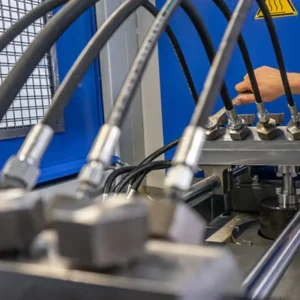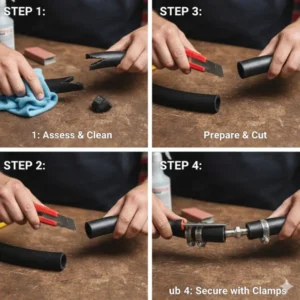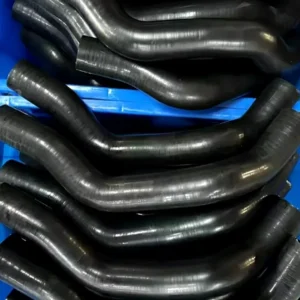We’d like to discuss a true workhorse in automotive and fluid-handling applications: CPE braided hose. If you’ve ever built a custom fuel system, upgraded fuel lines, or repaired a high-performance vehicle, you’ve likely heard of this term. It’s not just any rubber hose; it’s a specialized type of hose designed for exceptional performance.
In this guide, we’ll delve into what makes CPE braided hose special, explore its key benefits, and explain why it’s our top choice for demanding applications where standard rubber hoses just won’t cut it.
Why Do We Need a Better Hose?
In the high-stakes world of performance vehicles and industrial machinery, standard components often fall short. Rubber hoses, while inexpensive, are susceptible to degradation from modern fuels, oils, and extreme temperatures. A failure in a fuel line can lead to a fire, and a leaky oil line can cause catastrophic engine damage.
That’s where a CPE braided hose comes in. It’s designed to provide a more robust and reliable solution, ensuring the integrity of your fluid transfer system even under the most stressful conditions. Our goal is to show you why investing in this type of hose is a smart decision for both safety and performance.
What is a CPE Braided Hose?
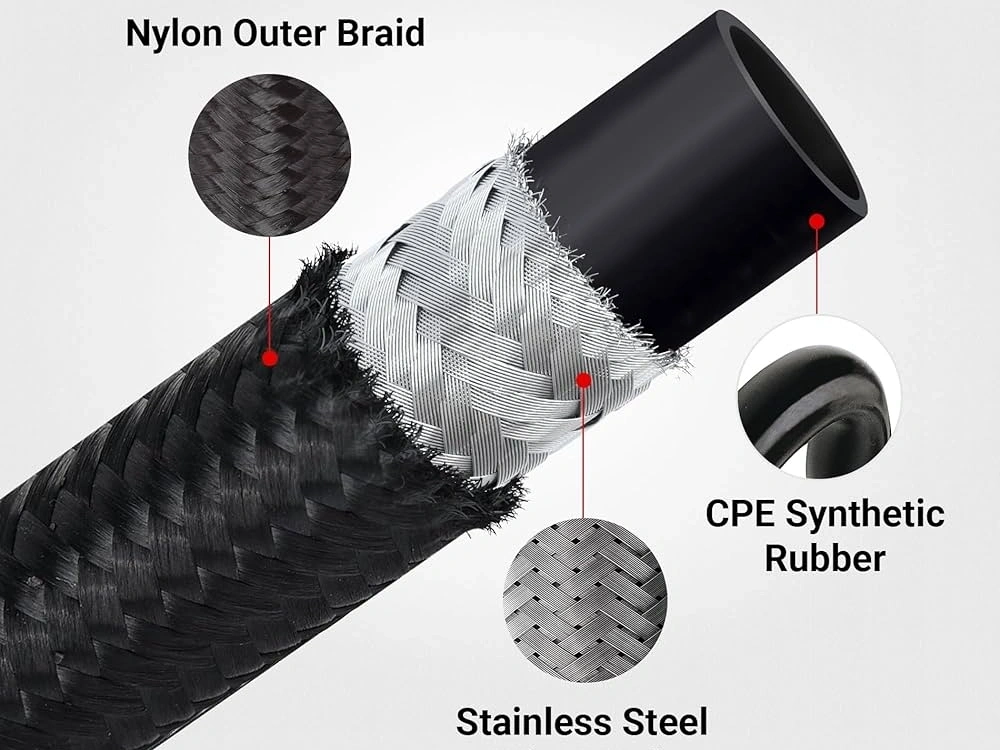
A CPE braided hose is a multi-layered hose specifically engineered for demanding fluid transfer applications. At its core is a synthetic elastomer tube made from Chlorinated Polyethylene (CPE). This inner tube provides excellent chemical resistance against a wide range of fluids, including gasoline, diesel, and ethanol-blended fuels. The outer layer is where the “braided” part comes in.
This is a woven mesh, typically made from high-strength stainless steel, which reinforces the hose, providing durability and a high-pressure rating. The combination of the CPE core and the stainless steel braid is what gives this hose its incredible strength, flexibility, and longevity.
Why Choose a CPE Braided Hose Over Rubber?
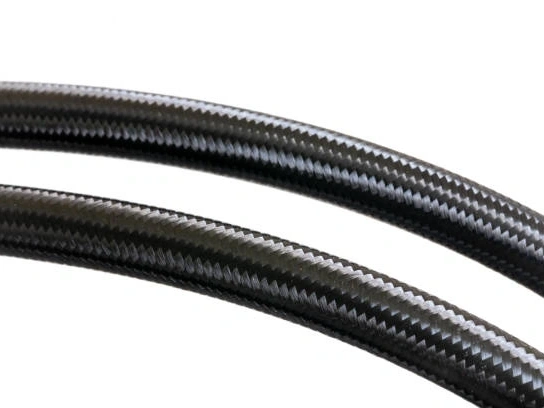
When we’re faced with a choice between a traditional rubber hose and a CPE braided hose, the benefits of the latter quickly become clear. While a rubber hose might be a suitable, low-cost solution for simple, low-pressure applications, it can’t compare to the durability and performance of a CPE hose. We’ve seen countless examples of rubber hoses cracking and degrading over time from exposure to modern fuels, which often contain additives that are aggressive to traditional materials.
- Superior Chemical Resistance: The CPE inner liner is a game-changer. It’s highly resistant to deterioration from ethanol, methanol, and other additives found in modern fuels, preventing the hose from becoming brittle and failing prematurely.
- High-Pressure Rating: The stainless steel braid isn’t just for looks; it significantly increases the hose’s working pressure capacity, making it perfect for high-pressure fuel injection systems and hydraulic lines.
- Extreme Temperature Tolerance: CPE braided hoses can handle a much wider range of temperatures compared to standard rubber lines, from freezing cold to scorching hot engine bays. This makes them reliable in all climates and performance scenarios.
- Durability and Abrasion Resistance: The woven stainless steel braid provides excellent protection against external damage. It resists cuts, nicks, and chafing, which is a major concern in crowded engine compartments.
| Feature | CPE Braided Hose | Standard Rubber Hose |
| Inner Liner Material | Chlorinated Polyethylene (CPE) | SBR/EPDM Rubber |
| Reinforcement | Stainless Steel Braid | Fabric or Polyester Braid |
| Chemical Resistance | Excellent (Ethanol, Gasoline, etc.) | Poor to Fair |
| Pressure Rating | Very High | Low to Moderate |
| Temperature Range | -40°F to 300°F+ | -40°F to 212°F |
| Abrasion Resistance | Excellent | Poor |
| Cost | Higher | Lower |
How Do We Identify a Quality CPE Braided Hose?
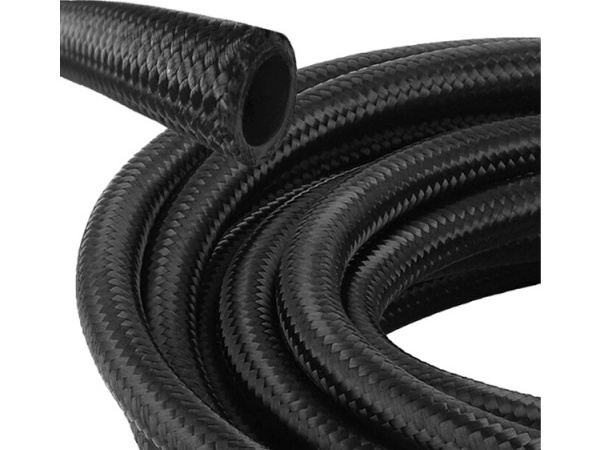
Not all hoses are created equal. The key is to look for a few specific indicators:
Markings and Certifications: A reputable manufacturer will stamp their hose with a part number, size, and sometimes a pressure rating. We always look for hoses that meet industry standards.
Inner Liner Color: The CPE core is typically black. If you cut a section and the inner liner is any other color, it might not be a true CPE hose.
Braid Quality: The stainless steel braid should be tight, uniform, and without loose or frayed strands. A high-quality braid indicates a strong, reliable reinforcement.
Overall Feel: The hose should feel flexible but robust. It shouldn’t feel overly soft or easily collapsible, as this could indicate a lower-quality inner liner.
What are the Common Applications of CPE Braided Hose?
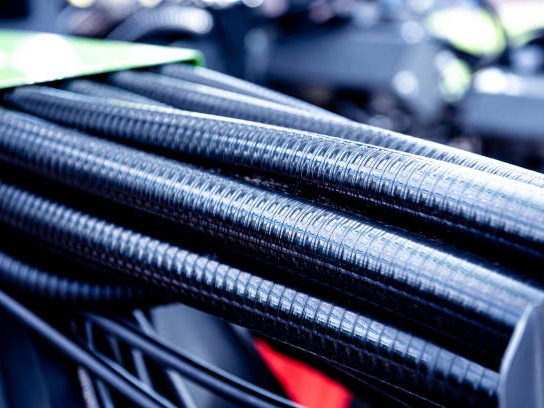
The versatility of CPE braided hose makes it a favorite across many industries. We see it being used in a wide variety of demanding applications.
- Automotive Performance: This is the most common use. CPE braided hose is perfect for fuel systems, oil cooler lines, and power steering lines on race cars and high-performance street vehicles. Its resistance to ethanol and high pressure makes it the ideal solution for these upgrades.
- Motorcycles: Many custom motorcycle builders use these hoses for their fuel and oil lines to ensure a clean, professional look and reliable performance. The braid offers both durability and a sleek aesthetic.
- Industrial Machinery: In industrial settings, these hoses are used in hydraulic systems, where high pressure and durability are a must. They can handle the rigorous demands of heavy machinery.
- Marine Applications: CPE braided hose is also used on boats and other marine vessels for fuel and oil lines due to its corrosion resistance and ability to withstand harsh marine environments.
What is the Difference Between CPE and PTFE hose?
The primary difference between CPE and PTFE hose lies in their core materials and the specific applications they’re best suited for. CPE stands for Chlorinated Polyethylene, a synthetic rubber that is flexible and cost-effective. We often see it used in applications like fuel, oil, and coolant lines in the automotive aftermarket because it offers good resistance to common hydrocarbons and a wide temperature range. It’s a popular choice for performance enthusiasts and race teams.
PTFE, or Polytetrafluoroethylene (commonly known as Teflon), is a synthetic fluoropolymer. It has an exceptionally slick, non-stick inner surface that provides superior chemical resistance and a much wider operating temperature range compared to CPE. Because of its non-porous nature, PTFE hose is ideal for applications involving corrosive fluids or where cleanliness is critical, such as in the food and beverage, pharmaceutical, and aerospace industries. While generally more expensive and less flexible than CPE, PTFE hose offers unparalleled performance in extreme and sanitary environments.
Conclusion
We highly recommend CPE braided hose for any project where performance, safety, and reliability are paramount. It’s an exceptional product, capable of handling challenges that standard hoses simply can’t. Its resistance to modern fuels and high pressures makes it a must-have for any seasoned hobbyist or professional.

